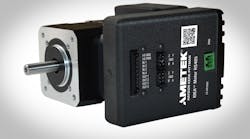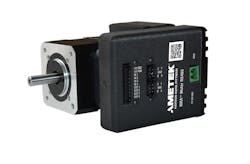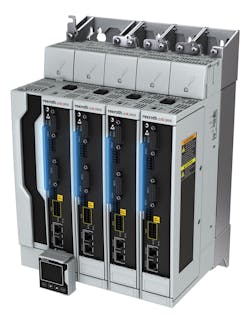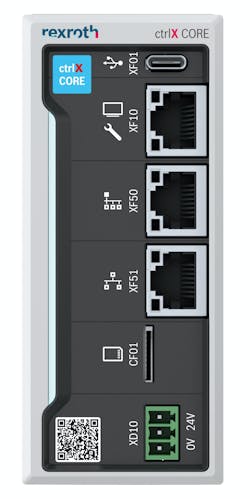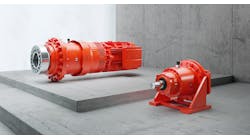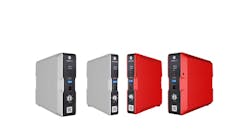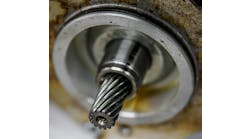Electronics continue to trend smaller and smaller, and industrial-automation applications are no exception. Where machine builders want a smaller footprint and easier programming, along with higher production, they’re looking for motors and drives that can do more with less. For tight spaces and quick integration, two manufacturers, Bosch Rexroth and Pittman, offer their solutions with a compact brushless motor and drive package and a servo drive that’s also PLC, inverter or power supply in one.
Visualize the motion
The Pittman Idea Motor has been designed in lab instruments, packaging machines, warehouse automation, entertainment equipment and industrial printing applications (Figure 1). “The Idea Motor is designed for customers who need a brushless motor but do not have room to run wiring harnesses between the motor and drive,” says Dan Lisowsky, product manager at Pittman. “The drive is pre-programmed to match the exact motor and feedback parameters, which saves valuable time in provisioning the motor-drive system.”
Figure 1: The Pittman Idea Motor has been designed in lab instruments, packaging machines, warehouse automation, entertainment equipment and industrial printing applications.
The advantages of a brushless motor include faster acceleration to high speeds and no wearable parts in the electrical circuit. “The only part that’s moving is the bearings. You’re just moving the magnetic field around the rotor,” Lisowsky says.
A brush motor can run with a simple power supply, but a drive is integral to a brushless motor. “A brushless motor needs electronics to switch the electric circuit around the rotor, and it will follow that,” Lisowsky says. “You have to have a drive with a brushless motor. If you’re using parts from different suppliers, there’s going to be some trial and error as to how big of a drive you need, and when you get it together, you test.” The integrated motor-drive system eliminates this process, he says.
“It also gives new users to brushless technology a powerful platform to base their designs,” Lisowsky says. The software and graphical user interface (GUI) allow users to visualize their motion. “It will give you a graph of what the motion profile should look like. It can also measure the profile, so if you have a loaded system and you want to do a move, you can do that, and it will display things like commanded position, actual position, velocity, current and voltages,” Lisowsky says.
The oscilloscope allows for such tweaking. “I’ve been on calls with customers that have issues, and we bring up the oscilloscope and do the motion and look at the parameters,” Lisowsky says. “Without the oscilloscope, it would have been more trial and error to figure it out.” The oscilloscope captures 10 parameters and displays two on a graph. “The user can display any two parameters, without having to run the motion again. This helps the user to identify overshoot, steady-state error, position tracking, velocity tracking, currents and voltages,” Lisowsky says.
[javascriptSnippet ]
Based on the motion, the software will calculate what would be the appropriate motion profile and select gains for velocity and position. A slide onscreen allows users to change those values, Lisowsky says. “Motions can be quickly executed in the same screen, and new data can be examined,” he says.
The drive software accepts gearbox and leadscrew parameters, which Lisowsky says makes programming very intuitive. The Idea Motor can operate either autonomously, in RS-485 networks, or in CANopen networks. The programmability and onboard I/O allow the motor to run autonomously, but it can also function as part of a network of drives, receiving and acting on commands sent from a central control device.
Via the GUI, users can write programs with actions, subroutines and loops. “Programs can act on external inputs and trigger external outputs through the onboard I/O. The unit can also function by receiving real-time commands through the streaming command set,” Lisowsky says.
“The matched motor-drive combination can operate within a large range of input voltages (12 V to 60 V) and can drive up to 3.4 A continuously through the motor.
Drive into the future
Bosch Rexroth also offers a servo drive that focuses on saving space, quick setup and control systems of the future. The ctrlX Drive was designed for discrete automation applications, such as material handling, pick-and-place, storage and retrieval and Cartesian robot applications (Figure 2).
Figure 2: The ctrlX Drive was designed for discrete automation applications, such as material handling, pick-and place, storage and retrieval and Cartesian robot applications.
The servo drive integrates important functionality that previously required extra space for more components. The compact modular drive can support as many as 40 axes per meter width. The small footprint for a three-axis system includes an integrated control (PLC) called crtlX Core. “CtrlX Drive’s converters can function as power supply units for inverters, freeing up additional shop floor space,” says Joaquin Ocampo, product manager at Bosch Rexroth.
The servo drive offers both single-axis applications and complex multi-axis machine systems. The scalable drive portfolio includes converters, single and dual-axis inverters, dc/dc converters and power and regenerative supply units.
The drive has a 50-mm width, and a complete Cartesian xyz system, for example, can run within a 100-mm footprint, Ocampo says. When it’s used as a converter drive, users can add ctrlX Core drive and it won’t change the width. “Then the drive can act as a power supply for a double-axis inverter, which is also 50 mm in width. Put those together, and you don’t need any additional accessories.”
Users can monitor the drive’s performance with diagnostics in the system and don’t have to memorize codes or look up numbers in manuals to diagnose problems. The ctrlX Drive’s full display shows text and full diagnostics. “It will show a dynamic QR code that you can scan with your cell phone, and then it will come back and tell you what’s going on,” Ocampo says.
The monitoring can also help with preventive maintenance, where a user can set a base for how the machine operates, for example, torque measurements, and monitor a measurement window, so if the torque goes above or below that window, it can indicate a problem.
Ocampo says this drive is designed for the future and will be ready for things such as artificial intelligence. “Since you can program with any language, you can program it to learn your process and learn what’s going on with your machine and help with preventive maintenance or the quality of products,” he says.
The drive is also ready for 5G communications. “It’s coming to our industry,” Ocampo says. The ctrlX Drive will also be ready for time-sensitive networking and its standard protocol for communication.
Consumers want more customized products, and manufacturers need to be flexible. “Many of these types of machines and applications produce parts at specific lot sizes and the challenge is to be able to produce in a lot size of one,” Ocampo says. “Many consumers want customized products, and so machine builders need to adapt equipment to these customer demands.” This drive can help machine builders to change from one tool to another and reconfigure a machine quickly, he explains. “If you have to reconfigure your layout in your factory, this drive can help you to do that. We have to think of the future, where the market is asking for specific customized products.”
For example, in a Cartesian-robot application with three axes, xyz, retooling a machine requires taking tools out and putting new tools in, which changes the space, Ocampo says. “So now you’ve changed the environment around the machine and you’ve changed the retooling. The system still needs to tell the machine it changed to a new product, which is all app-based communication,” he says. “You tell it to run this app, and it runs the app for the next size of products.”
The drive also is designed to save programmer time. With a linear or rotary machine, or connecting a rotary servo to a linear axis, can require many incremental encoder calculations to tell where a piece has moved or where it’s at. “This drive actually tells you,” Ocampo says. “Once you tell it that it’s a rotary system or a linear system and to move 3 inches, it moves 3 inches. There’s no other calculations necessary to do; the drive does everything for you.”
The drive includes a processor for the motion and a processor for the control (crtrlX Core). “The processor for the motion is for the motion. It doesn’t get bogged down doing motion and control PLC,” Ocampo says.
Machine builders are under pressure to meet the demands of the end users, which is driven by their customers and market demands. This means machine builders need flexibility. “CtrlX Core can be integrated into Rexroth’s crtlX Drive, embedded controllers or plug-in cards without additional hardware, allowing a seamless transition between servo drives, embedded box controllers with I/O and industrial PC (IPC) card slots,” Ocampo says (Figure 3).
Figure 3: CtrlX Core can be integrated into Rexroth’s crtlX Drive, embedded controllers or plug-in cards without additional hardware.
